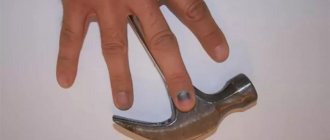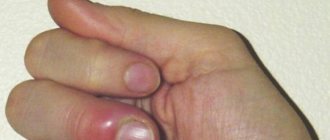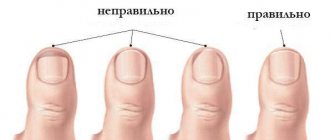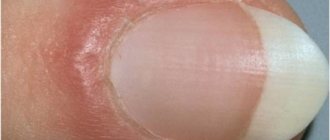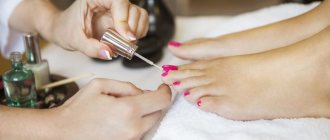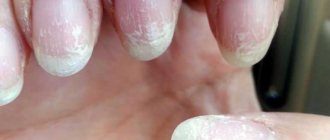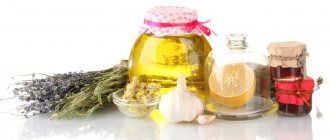Improper pedicure results in pain, inflammation and suppuration. As a result, the toe breaks out near the nail, causing severe discomfort. The most popular cause is an ingrown toenail; sometimes the disease is caused by a fungal or bacterial infection.
In all cases, it is impossible to do without consulting a specialist. It is imperative to provide first aid as early as possible - 5 tips will answer the question “What to do if your toe breaks?”
First aid
Before learning about the provoking factors of suppuration, I would like to talk about first aid. Regardless of the cause of the illness, it is necessary to provide it as early as possible.
Ideally, you should act immediately after receiving an injury or noticing the first symptoms. What to do if your finger near the toenail is festering:
- Inspection. It is recommended to immediately examine the finger - perhaps the cause of discomfort is a splinter or wound. You should not remove the splinter yourself - this should be done by a surgeon.
- Treatment. After removing the splinter or hangnail, the wound is treated with an antiseptic. Whatever you have on hand will do: hydrogen peroxide, iodine (need to be diluted with water), Chlorhexidine.
- Bath with manganese. It is better to immerse the entire foot in a weak solution of potassium permanganate (the color should be pale pink) and hold for 10-15 minutes. You cannot use hot water, otherwise the inflammation will increase.
- Anti-inflammatory ointment. Wipe the skin dry, apply Levomekol or another agent that has an anti-inflammatory effect to the sore spot.
- Bandage. Bandage the thumb and little finger, making a not very tight bandage. Keep the compress with ointment for 8-12 hours, then change it.
It is advisable to avoid vigorous activity and not wear shoes. As a rule, 1-2 days are enough for treatment. If your toe breaks out and the pain gets worse, you should consult a doctor.
Causes of suppuration around the nail
Pain, redness, swelling - all this indicates the development of an inflammatory process. It is caused by various factors, for example, the penetration of pathogenic bacteria due to poor-quality pedicure, neglect of personal hygiene rules, and injuries to the nail plate. Usually the culprits are gram-positive staphylococcus bacteria that penetrate through wounds or scratches. The main reasons why the finger is swollen and festered:
- injuries to soft tissues and nails;
- performing a pedicure with tools that have not been processed;
- fungal infection affecting the foot and nails;
- ingrowth of the nail into the deep layers of the skin;
- diseases of internal organs (circulatory, endocrine system);
- dryness, cracking of the epidermis.
Hangnails are another common cause caused by improper foot treatment or lack of vitamins. Sometimes small wounds after cutting nails are invisible, but after 2-3 days they begin to fester. Pain appears, and pus accumulates near the plate. You must immediately use iodine or another remedy that draws out the pus on the toe near the nail.
Treatment
You need to begin restoring the integrity of the skin near the nails immediately; you can do this yourself if pathogenic bacteria have not yet penetrated the open wound.
Several methods can be used to restore the skin around the nails:
- Wipe the area of pus discharge daily with hydrogen peroxide – 3 times;
- Take medicinal steam baths every day before bed with a decoction of medicinal herbs;
- Apply Vishnevsky ointment or Levomekol, applying the compositions to gauze folded several times and applying it as a compress to your finger for 30 minutes. It is recommended to apply the compress every day;
- If there is a pulsating abscess, mechanical removal of the discharge must be performed. It is recommended that the procedure be performed by a surgeon.
If the pus does not come out spontaneously, treatment usually takes 5-6 days. After the fluid is released, the wound recovers within 2-3 days, subject to the doctor’s instructions.
Types and dangerous symptoms
An abscess often indicates paronychia and felon, which do not appear in 5 minutes - it takes several days to develop. As a rule, at the beginning a person notices pain when palpating or walking, then redness and inflammation appear. The wound (if present) becomes wet, releasing pus. Over time, exudate accumulates, causing severe discomfort. When the toe festers near the nail, no one usually knows what to do, and the pain accompanies even at rest. The disease bothers me so much that it is impossible to cut my nails or put on shoes. In addition, an unpleasant odor emanates from the feet as the plate festers.
When the skin is affected, there is slight swelling with redness, pain is present only when pressing hard on the finger. Next, the disease moves to the periungual fold (the place to which the nail plate adjoins). Pus appears, discomfort when walking, severe swelling. Many people talk about a throbbing, bursting pain from the inside - this is an abscess on the toe that has formed under the nail.
If the tendons are affected, the person notices severe redness, stiffness and even partial loss of movement. The most serious is a purulent bone lesion, causing intense pain, swelling of the entire foot, and hyperemia.
In advanced cases, there is fever, chills, general malaise, and headache. Such symptoms indicate tendon suppuration and blood poisoning. It is necessary to urgently seek medical help.
Prognosis and complications
The most effective is surgical removal of pus from under the nail, because conservative treatment only temporarily relieves the problem, but does not eliminate it completely. It is advisable to refuse surgery only if there are absolute contraindications (intolerance to anesthesia, undergoing treatment for a more serious disease). In other cases, it is still advisable to operate on the panaritium.
If you neglect the disease and do not seek medical help on time, the situation will worsen. The finger will begin to break out more and more often and more painfully, the nail may begin to peel off, but this is not the worst thing. Inflammation can spread to the hand, the entire arm and the body. And this requires not only local surgery on the finger, but also full treatment.
The most serious complications of pus under the nail are:
- sepsis (blood poisoning that can be fatal);
- phlegmonous extremities (purulent inflammation will spread deeper, lead to necrosis, and a finger or even a hand will have to be amputated);
- Tenosynovitis (impaired mobility of the fingers due to necrosis of the tendons).
After surgery, the risk of relapse is minimal. Timely small intervention eliminates dangerous consequences and unpleasant symptoms. After all, the constantly secreted pus smells bad, and a sore finger prevents you from concentrating on work and life in general.
Diagnostics
When your toe breaks out near the nail, it is better not to start treatment on your own, as your health may worsen. You can seek help at the onset of the disease from a dermatologist or podiatrist (a specialist who deals with foot diseases). If the problem is advanced, you should immediately go to see a surgeon, who will open the abscess.
In most cases, the patient is prescribed a series of tests to identify the cause. Sometimes a toe rots due to diabetes mellitus or other severe pathologies of internal organs. In this regard, consultation with highly specialized specialists is required: an endocrinologist or cardiologist. If your toe breaks out, your doctor will tell you what to do.
Treatment at home with medications
A minor inflammatory process can be easily eliminated with local remedies. They can be rubbed into sore spots or made as a compress at night. The most popular remedies that will help if your big toe breaks near the nail:
- Antiseptics. The first aid kit must have disinfecting solutions. The cheapest are iodine, peroxide and Chlorhexidine. You can wash the wound 3-5 times a day to avoid infection.
- Anti-inflammatory and antibacterial ointments. They relieve inflammation, reduce pain and prevent the infection from spreading further. Available products: Levosin, Vishnevsky ointment, Levomekol, Protegentin.
- Antifungal medications. For suppuration caused by a fungal infection, it is customary to use antimycotics in the form of ointments: Clotrimazole, Exoderil, Nizoral. Sometimes it is necessary to choose oral capsules or tablets, such as Diflucan or Nystatin.
- Nonsteroidal anti-inflammatory drugs for systemic use. If your toe breaks out and the infection continues to spread, severe discomfort will persist. You should choose non-steroidal drugs for internal use. Nimesil, Ibuprofen and Nurofen will relieve pain and also lower body temperature.
- Antibiotics. The addition of a secondary infection is eliminated with the help of antibiotics: Amoxiclav, Flemoxin, Cefuroxime. They are taken orally, but the medications cause side effects.
It is not advisable to use medications on your own; each of them has contraindications. The doctor prescribes medications based on the diagnosis and condition of the patient. It is unacceptable to give any drugs to a child.
Surgical intervention
Sometimes a patient consults a doctor too late, when an abscess has formed on a toe or hand, and medications are not able to help. Surgical intervention comes to the rescue, during which the abscess is opened and the pus is removed.
The procedure is performed under local anesthesia, but it is not necessary if the nerve fibers are damaged. The yellowish or white color of the tissues around the nail plate will tell you about this. The operation is performed in several ways.
After surgery, a course of antibiotics is always prescribed, otherwise secondary infection is possible. The wound requires careful care, including the use of antiseptics and healing ointments.
Treating an abscess with surgery and medication
You should consult a doctor if you notice chronic or increasing panaritium. As a rule, this is a purulent sac located near the plate. If it appears on the skin, it is better to seek medical help. At the clinic, the abscess area will be cleaned and an antibacterial bandage will be applied. If pus goes under the nail, the doctor will have to cut off part of the nail and clean out all the formations. In this case, you need to take a course of antibiotics, provided that the disease has not caused complications.
The cut plate will grow back within six months. For the first three weeks, you will need to follow the doctor’s strict recommendations, wash the affected area, change the bandage and take prescribed antibiotics. You will have to forget about manicure for a while, because the main task will be to cure the nail.
Traditional medicine against abscess
If your finger breaks slightly near the toenail and there is no fever or severe pain, you can cope on your own. Traditional healers know many remedies against inflammation of the lateral ridges. They do not require expensive ingredients and are easy to prepare at home.
The first remedy is onions, which are baked in the oven and grated. In 2 tbsp. l. onion you need to add 1 tbsp. l. grated laundry soap, then mix thoroughly. Spread the mixture in a thick layer on the abscess on the big toe and secure with a bandage. It is recommended to change the bandage every 4-6 hours.
A medicinal gruel made from grated carrots, beets, and onions will quickly relieve inflammation, and aloe will eliminate the abscess. All ingredients are crushed and take 1 tbsp. l., after which a bandage is made in the same way as the previous recipe. Aloe can be used separately: apply a cleaned leaf to the suppuration, after steaming your finger.
A baking soda solution can also relieve inflammation in just a few uses. Dilute 1 tbsp in 120 ml of warm water. l. soda and the same amount of salt. You should hold your finger in the liquid for 5-7 minutes, repeat every 8 hours.
Cabbage leaves are another remedy that can draw out pus. The leaf must be beaten or crushed with your hands so that it begins to release juice, then applied to the big toe. Secure with a bandage, hold for 12 hours, and repeat in the morning. In cases where the pulsation and discharge of pus intensified, swelling appeared, and it was difficult to move the leg, you should forget about traditional methods.
Prevention
Hygiene will help protect yourself from such a small but significant problem. It all starts with her. If you keep your hands clean, then even if microtraumas appear on the skin, no infection will get inside. And people working with dirty (in terms of bacteria) objects should protect their hands with gloves and remember to take them off when resting.
A healthy immune system is also important. It is more difficult for a weakened body to cope with even the most common bacteria, not to mention staphylococcus. And in general, a healthy lifestyle is the prevention of not only pus under the nail, but also many other diseases.
Suppuration of periungual tissues or panaritium is a disease that can be caused by both mechanical damage and general infection of the body. Characteristic symptoms allow you to identify the disease and remove pus from under the nail on your toe or hand in the most effective way. A timely visit to a surgeon will prevent the spread of the lesion.
Danger of disease
A festering wound causes serious consequences, and they can affect not only the foot, but the entire body. Treating an abscess on the toe prevents severe inflammation that affects the bones and tendons, causing impairment of the functionality of the foot.
The most common occurrence is complete or partial detachment of the plate from the bed, as well as deformation. If a finger rots near the toenail, urgent amputation is required. Sepsis is considered the most serious, leading in many cases to death.
Causes of pathology
Pus under the toenail begins to accumulate due to the pathological activity of microorganisms. Bacteria enter through existing small wounds or cracks. Factors provoking the development of panaritium can be:
- improper nail care;
- lack of disinfection of pedicure instruments;
- injuries;
- splinters under the nails;
- ingrown nails;
- fungal infection;
- endocrine diseases;
- metabolic disorders in the body.
The appearance of pus under the nail is a consequence of the work of the protective system. Essentially it is a mixture of living and dead white blood cells. Such blood cells accumulate in areas where the inflammatory process occurs. The immune system ensures the destruction of pathogens that have penetrated under the nail plate and into the soft tissues.
Inflammation on the toes develops quickly. This is due to the difficulty of maintaining absolute purity. High humidity is a favorable environment for the development and activity of pathogenic microorganisms.
Treatment of pathology is associated with stopping the inflammatory process. It is also important to draw out any existing pus from under the nail. If you suspect the presence of panaritium, you should consult a doctor. It is not possible to remove pus yourself in all cases.
Prevention of the disease
Fortunately, you can avoid the unpleasant consequences of a poor-quality pedicure by following the recommendations. It is imperative to disinfect instruments used to treat skin and nails. If you accidentally cut yourself or get a splinter, you need to disinfect the wound so that your finger doesn’t break. It is recommended to cut the plates perpendicularly without rounding the edges. Wearing tight shoes contributes to the appearance of ingrown toenails and then pus.
Sharp pain in the foot, hyperemia, pus on the foot near the nail are signs of an infectious infection. It occurs as a result of improper pedicure, diseases of internal organs, and the use of contaminated instruments.
The disease can not only cause nail deformation and deterioration in appearance, but also seriously affect health. For treatment, they use various medications, traditional recipes, or resort to the help of a surgeon.
